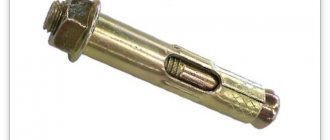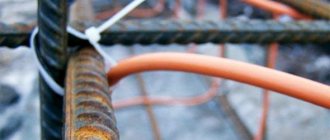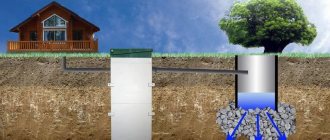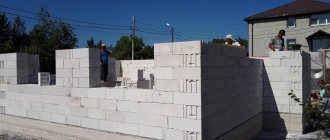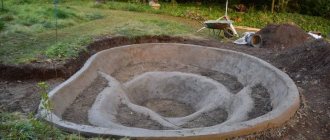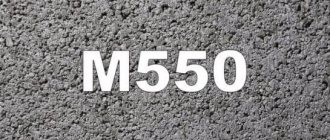In the construction industry, when concreting a structure, additives for rapid hardening of concrete are in particular demand. They increase the strength characteristics of the material, which makes it possible to reduce the duration of its exposure and speed up the entire construction process as a whole. The use of special accelerators is an effective technological technique with which you can reduce the cost of building materials and improve the economic and technical performance of an organization.
Chemistry of the process
As part of a concrete mixture, cement stone is a product of hydration reactions that occur when cement is mixed with water.
Cement is the main component of the mixture; The strength of the finished concrete and the speed of its hardening depend on its brand and ratio with water.
Important!
Water-cement ratio (W/C) is the ratio of the amount of mixing water to the amount of cement. It is usually 0.3-05 and higher.
Cement contains compounds such as calcium silicates, aluminates and aluminoferrites. When these compounds are mixed with water, chemical reactions begin, accompanied by the release of heat (due to which the rate of hydration reactions increases).
Important!
The faster the aqueous solution is saturated, the better and faster the crystallization occurs, that is, the setting of the cement. This is why concretes with reduced water content set faster.
The concrete hardening process consists of two phases:
- grasping,
- hardening.
Setting of concrete under conditions of optimal temperature and humidity begins after 2 hours and proceeds quite quickly, within an hour. In this phase, the concrete can be influenced and remains mobile.
After the end of the first phase, hardening begins. Under optimal conditions, stripping strength is achieved on the 7-10th day, the design strength is achieved after 28 days, then the strength gain continues for several more months, but at a very low speed.
METHODS FOR ACCELERATING CONCRETE HARDENING
To reduce the time required for stripping monolithic and prefabricated concrete and reinforced concrete structures and accelerate their delivery to operational load, various methods are used to intensify hardening at an early age (1..7 days) of cement concrete. Depending on the type of building structures being manufactured, concreting conditions, and the required time frame for concrete to gain tempering strength, methods for accelerating the hardening of concrete are used:
-chemical, based on the use of chemical additives - hardening accelerators;
- thermal, based on increasing the temperature of hardening concrete by steaming or electrical heating (electric heating);
-mechanical, based on the use of pre-ground cement in a dry or wet way with the addition of gypsum 2...5% by weight of cement in ball mills or vibratory mills.
The greatest accelerating effect is achieved when using a complex method that includes the above methods of accelerated hardening.
Construction standards allow the use of compounds as chemical additives - concrete hardening accelerators, the types and dosage of which are indicated in Table 18.1.
Table 18.1
Chemical additives – hardening accelerators for concrete
| Type of chemical additive | Symbol | Recommended dosage, % of cement consumption | Note |
| Potash, K2CO3 | P | 3,0…5,0 | Salt with pronounced alkaline properties |
| Calcium chloride, CaCl2 | HC | 1,5…5,0 | Sharply intensifies corrosion of fittings and equipment |
| Calcium nitrate, Ca(NO3)2 | NK | 1,5…2,5 | Rapid setting of cement and thickening of the concrete mixture is possible |
| Sodium nitrate, NaNO3 | NN | 2,0…3,0 | Rapid setting of cement and thickening of the concrete mixture is possible |
| Sodium chloride, NaCl | XN | 1,0…4,0 | Sharply intensifies corrosion of fittings and equipment |
| Sodium sulfate, Na2SO4 | CH | 0,5…2,0 | Possible efflorescence on the concrete surface |
| Nitrite – calcium nitrate, Ca(NO2)2 + Ca(NO3)2 (Mixture of calcium nitrite and calcium nitrate in a 1:1 ratio by weight) | NOC | 2,0…3,0 | When used, rapid setting of cement and thickening of the concrete mixture is possible. |
| Nitrite - nitrate - calcium chloride, Ca(NO2)2 + Ca(NO3)2 + CaCl2 (Mixture of nitrite - calcium nitrate with calcium chloride in a 1: 1 ratio by weight) | NNHK | 1,5…2,5 | When used, rapid setting of cement and thickening of the concrete mixture is possible. |
| Urea, CO(NH2)2 | M | 2,0…4,5 | In case of overdose, concrete hardening may be slowed down |
The accelerating effect of the electrolyte salts indicated in the table is based on their ability, when interacting with cement minerals, to activate their hydration.
Thermal methods for activating concrete hardening are based on accelerating the rate of chemical reactions of cement hydration with increasing temperature. Thus, when the temperature of the concrete mixture increases from 20°C to 80°C, the rate of hydration reaction increases 6 times. Of the various methods of heat treatment of concrete, steaming has become the most widespread in factory conditions, and in construction site conditions - electric heating and electric heating.
Steaming of concrete is carried out in thermal chambers, in which, due to the supply of saturated water steam at atmospheric pressure, a temperature T = 80...90°C and high air humidity φ = 95...100% are created. The steaming regime must necessarily consist of a number of successive stages: the stage of preliminary holding of concrete of molded products or structures at normal temperature, the stage of raising the temperature to the isothermal heating temperature, the stage of isothermal heating and the stage of cooling (cooling) the concrete to normal temperature.
To carry out electrical heating of concrete structures, metal electrodes and heating wires in an insulating sheath are used, placed in the concrete body. Electrical heating of concrete is carried out using electrical heating devices of various designs - thermal energy emitters.
With mechanical grinding of cement, its specific surface area increases significantly. Cement with a developed specific surface area of grains hardens more intensively. This is explained by the fact that simultaneously a larger amount of its substance enters into the reaction with the mixing water.
What determines the rate of hardening?
Factors influencing the rate of hardening:
- strength class (grade) of cement, if the regulatory document provides for division by strength classes (grades) in accordance with GOST 31108-2003 “General construction cements. Technical specifications" (old designation - cement grade (M)); 5.4.3 Marking must be clear and contain:
- water cement ratio;
- temperature at which solidification occurs;
- air humidity;
- presence of heat and humidity treatment;
- special additives.
How long does concrete harden: features, graph, table
The main question of this article is how long does cement harden. To understand the process, a graph, table and accurate data will help us. This is useful information for anyone who decides to work with concrete structures, which are needed everywhere today.
After studying this material, readers will learn:
- what is compressive strength?
- what concrete grades say;
- How long does the concrete mixture harden in frost and heat above 30°C?
Strength of concrete
Compressive strength is the main characteristic of any concrete mixture. It is in this parameter that concrete grades differ. The mixture gains the required strength within 25-30 days, regardless of the brand. This feature forces workers to wait for a certain time. During the first 6-8 days, concrete gains strength more actively than in subsequent weeks - already during this period the concrete gains about 60% of the strength indicated in the brand.
Full strength will appear only after 28 days of ripening. Some workers, in order to save time, decide to load the structure ahead of time. Of course, this leads to a deterioration in the quality of the entire building. For the design to be reliable, you need to wait the full time. It makes sense to dismantle the formwork only after 8 days.
Conditions for high-quality hardening
These conditions include:
- positive temperature, which should be in the range of 18-22°C;
- air humidity, which should be about 90% or more.
Such conditions are not always present; the solution is moistened sand, sawdust or special chambers. Concrete hardens faster and better if it is in a humid environment. It is not recommended to leave the mixture in the open air, as all moisture will be removed from it, and the strength of the concrete will be minimal.
The graph shows the relationship between time and temperature.
When to accelerate hardening
The processes of setting and strengthening require acceleration:
- If necessary, carry out construction work in winter to reduce the cost of heating the concrete.
- When early stripping is needed.
- If necessary, continue construction earlier than after 28 days.
- For the production of a large number of small concrete products (production of paving stones, paving slabs).
- To optimize strength.
How long does it take for concrete to harden?
When planning construction work, it is necessary to take into account how long it will take for concreting. If the material begins to harden faster than it is poured into the prepared mold, the strength and durability of the structure will decrease. To avoid such overlaps, it is necessary to understand what factors accelerate and slow down the hardening process of the finished solution.
How concrete hardens
Setting of concrete is the transition of a building material from a solution to a solid form. This process is divided into two stages. The shorter stage of concrete hardening is the thickening of a mixture of cement and water as a result of a chemical reaction. The final transformation of the solution into a solid structure occurs after the second stage of solidification.
Standard hardening time for different brands of concrete mixture:
- M200 - about 2 hours;
- M300 - about 2 hours;
- M400 - about one and a half hours.
Hardening ends when chemical hydration of the cement is completely completed. For lean concrete, the hardening time lasts an average of a week. Brands of building mixtures intended for pouring the foundation harden on average within two weeks.
How to speed up the hardening of a concrete mixture
There are different ways to increase the curing speed.
Reducing the water-cement ratio
Reducing the mixing water promotes the rapid formation of a concentrated solution in which crystallization occurs better, which reduces the setting time.
Disadvantages of the method:
- a decrease in the mobility of the solution, due to which it is more difficult to process, fills the prepared volume less well, and the finished concrete may have cavities, which will significantly reduce its quality;
- too strong a decrease in W/C leads to a change in the characteristics of the finished product (fragility, decreased strength);
- increased cost of work due to increased cement consumption.
Reducing the water-cement ratio with the simultaneous addition of a plasticizer
To prevent the negative characteristics of a solution with low W/C, a plasticizer is added to it. It allows you to reduce the W/C and at the same time increase the mobility of the mixture, increase the speed of hardening and the strength of the finished product.
How to measure the strength of concrete
To measure the strength of concrete, you can use one of the following methods:
- Prepare a sample for measurements in advance. For this method, a concrete blank is prepared, which after a certain period of time will be subjected to a series of tests. The workpiece is placed in the same conditions as the main concrete structure.
- Use of ultrasonic devices for assessing the strength of concrete. The most popular method used in the construction of large construction projects. The operating principle of an ultrasonic device is extremely simple: the stronger the concrete, the faster the ultrasonic waves move inside it.
If you use an ultrasonic strength meter, you will not need to use various formulas to find out how long concrete hardens. The structure will be subjected to load immediately after obtaining the required strength indicators.
Using a special device, it is possible to measure strength indicators in the shortest possible time Source stefs.ru
How to care after installation
In order for the products to work longer and not require regular calls to the technician, much less replacement, you need to follow simple rules for operating the products:
- PVC profiles and double-glazed windows must be washed 1 or 2 times a year to remove dirt. Abrasive agents and overly aggressive solutions should not be used. For windows, you can use special glass cleaners, and for the profile, warm water and soap is enough.
- The seal and hinges also require cleaning from dirt and lubrication. It is separate for each fitting and is sold in stores. The seal is lubricated with silicone or products based on it so that it does not lose its elasticity. The hinges require oil (lubricant). It is enough to apply a couple of drops, open and close the sash, and remove the excess product.
- When the seasons change, if any defects appear when opening or closing the door (creaking, poor pressure, draft), the awnings need to be adjusted.
- You can turn the handle on a PVC door only when the door is closed. In the open position and in the ventilation state, the handle cannot be raised or lowered, otherwise the top canopy will come out of the clutch. To fix this, close the door tightly and set the handle to the “open” position.
- The protective film that was on the door during installation must be removed no later than a month later. Otherwise, the sun will simply “stick” to the surface, making it difficult to remove.
- You cannot lean on an open door, much less hang clothes on it. Likewise, you should not place any objects. In case of strong draft or gusty wind, it is better to keep the door closed.
Sometimes owners of plastic doors and windows complain about problems such as fogging. This is due to the tightness of the structure. You can avoid this problem if you ventilate the room daily for 15 minutes.
Installing plastic doors is not such a complicated procedure. You can entrust it to professionals or do it yourself, following the sequence of work. The final step is always to adjust the awnings to ensure proper door operation.
Chimney installation
Before installing a floor-standing gas boiler, a smoke removal system should be installed. The unit is placed on the finished base, after which the location of the chimney is marked. However, these calculations can be carried out without installing a boiler
It is important to note that the diameter of the smoke exhaust pipe must correspond to the power of the floor-standing gas unit:
- for models with an open combustion chamber, a separate smoke exhaust of appropriate power is used;
- for devices with a power of less than 31 kW, a pipe with a cross-section of more than 14 cm is suitable;
- for units more powerful than 39 kW, choose a system with a diameter of 16 cm;
- heating devices with a closed combustion chamber are equipped with coaxial type chimneys.
According to SNiP requirements, a chimney cannot be built next to a window. The minimum distance from it to the pipe must be 600 mm, otherwise combustion products will flow directly into the window.
The chimney outlet above the roof surface is made in height from 50 cm and above.
Conditions for the use of concrete hardening accelerators
The favorable temperature for hydration is plus twenty degrees and humidity ninety percent.
Humidity must be constantly maintained to ensure that the hardening process does not stop. If there is not enough water during the hardening process, the structure will be fragile and lose its solidity.
At zero temperature, concrete does not harden.
At very low temperatures, water becomes ice. To ensure concrete hardening, it is heated and, thanks to hardening accelerators, the heating time is significantly reduced.
In what cases are concrete hardening accelerators used?
- When construction work is carried out during the cold season, that is, in winter.
- If there is a need to remove the formwork earlier.
- So that construction work can resume before the concrete has cured.
- When producing large volumes of piece reinforced concrete products.
If you use concrete hardening accelerators, you can use fewer forms in the manufacture of reinforced concrete products, while the quality of the products will remain unchanged.
To optimize the strength properties of concrete and the plastic properties of mortar that has undergone hardening, chloride-based mixtures are used in construction.
Such mixtures are highly effective and low in price. But there is only one drawback - the finished product cannot be processed in an autoclave.
Additives that accelerate concrete hardening are plasticizers and are added when mixing concrete along with all the ingredients. The additive for rapid hardening of concrete must be added in doses.
Many additives cannot be used for mortars made of aluminous cement, and the use of reinforcement made of thermally strengthened steel in concrete products is also unacceptable. These restrictions do not apply to sodium sulfate.
